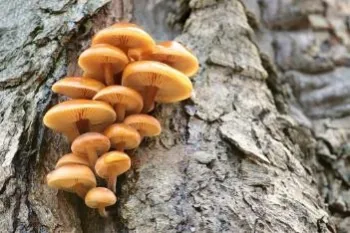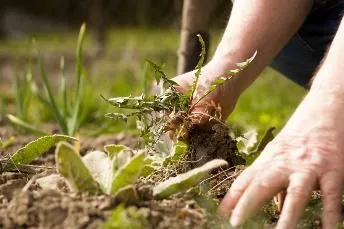Pests of the Season
Cue in the tune of The Music Man singing “Ya Got Trouble, Friend”, either you're closing your eyes to a situation you do not wish to acknowledge, or you are not aware of the caliber of disaster indicated by the presence of pooling water in your yards and gardens. Well, ya got trouble my friend, right here in San Joaquin County. Trouble with a capital “T” And that rhymes with “P” and that stands for Pooling Water. Stop the music. Let's take a look at how a deluge of rain or water may affect what we usually expect in the way of disease, insects, and weeds amongst our plants.

Too much moisture in the plant soil causes oxygen deprivation, i.e., aeration deficit to the roots of the plant. Commonly, roots become waterlogged. Roots and the basal trunk (crown or root collar) give structural support to the plant and function to transport nutrients and water to the rest of the plant. Soggy soils are the primary cause of root and crown disease. Often the first symptom of root disease shows in the foliage as chlorosis, wilting, and discolorations (symptoms mimicking nutrient deficiencies). Disease pathogens such as Demataphora and Phytophthora are normally in many soils but thrive in overly moist, humid conditions and cause their most severe symptoms in soil near saturation. Their growth isn't normally seen above ground. But an exception is the wood decay fungi Armillaria. If clusters of mushrooms are seen around the base of a tree, suspect the tree may be hazardous.

Almost all weed seeds won't be affected by sitting in water for a short period of time. For the most part, unless the water sits there for more than a week, most trees, shrubs, and turf should be fine. Weeds thrive in wet, compact soil. Wet weather creates ideal conditions for their germination and growth; and their seeds and reproductive parts are ready made to be transported. Flood waters, vehicle underbellies, shoes and clothing, and animal fur can transport weeds around and to your yard. Flood waters wash away desirable nitrogen from the soil. At the same time, many weed species don't like nitrogen in the soil. The good news is that weeding by pulling up by the roots is easier done when the soil is wet and soft.

Insects/ Pests
Actually, insects are even more affected by heavy rains and floods than many things. Unfortunately, home infestations commonly start in rainy weather, examples are cockroaches, ants, centipedes, silverfish, termites, and mosquitoes. When water is excessive and insects' homes are flooded, they lose their normal food source and head indoors into human homes. Standing water is the perfect breeding ground for mosquitoes. Termites get a lot of their nutrition from the water-damaged wood of roots, organic mulches, and rotting house structures. Flood surviving plants and vegetables can have increased moisture ultimately increasing the food source for many garden pests, such as aphids, slugs, and snails.
After calling your San Joaquin County Master gardeners to chat about water-resistant native plants, raised garden beds, mulching, soil amendments, Integrated Pest Management (IPM) measures, and rain gardens (209-953-6112) or emailing at anrmgsanjoaquin@ucanr.edu your tune may change to: Cue in music of Frank Sinatra singing tune of “New York, New York”. These little town blues. They've all washed away. We've made a brand-new start of it, in old SJ County!
